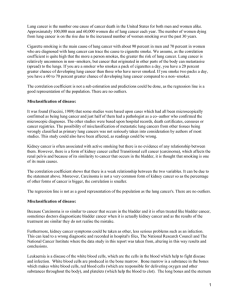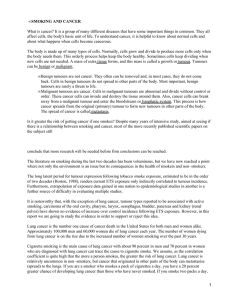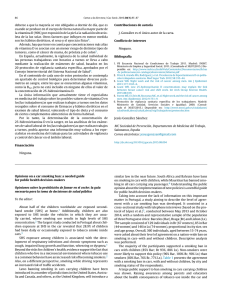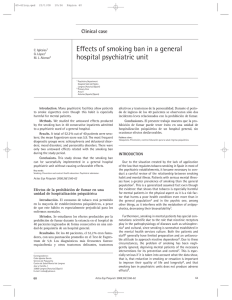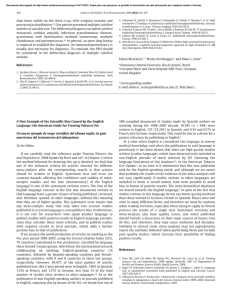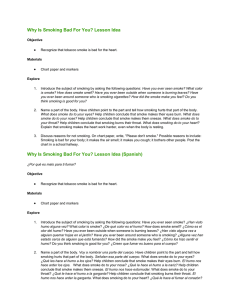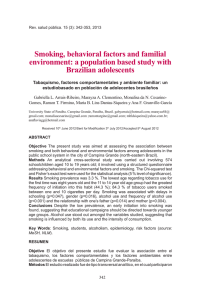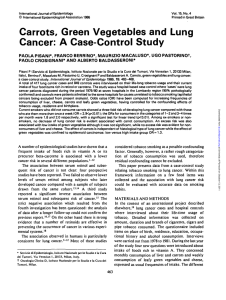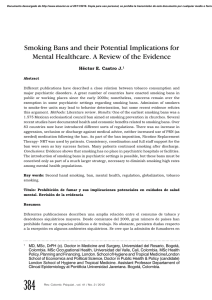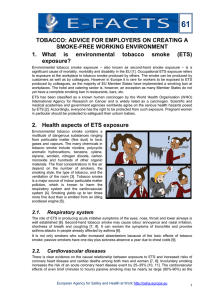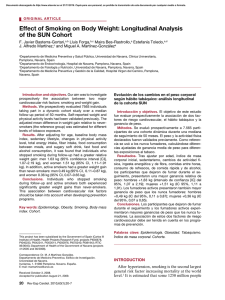Women and Smoking: Fatal Attraction
Anuncio
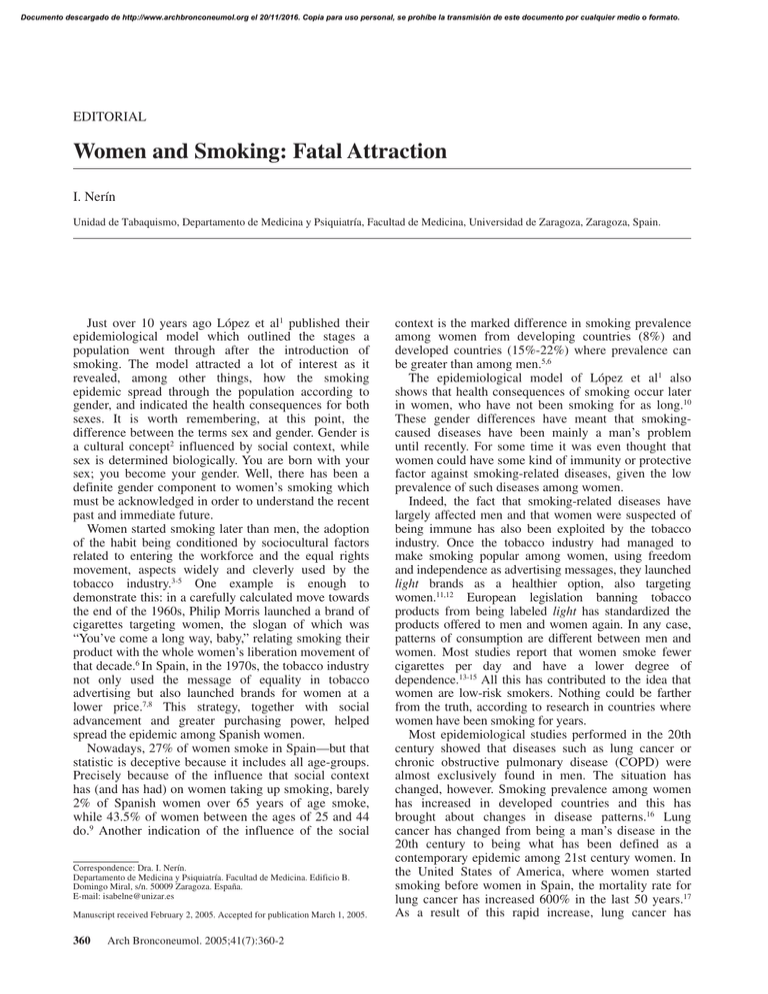
Documento descargado de http://www.archbronconeumol.org el 20/11/2016. Copia para uso personal, se prohíbe la transmisión de este documento por cualquier medio o formato. EDITORIAL Women and Smoking: Fatal Attraction I. Nerín Unidad de Tabaquismo, Departamento de Medicina y Psiquiatría, Facultad de Medicina, Universidad de Zaragoza, Zaragoza, Spain. Just over 10 years ago López et al1 published their epidemiological model which outlined the stages a population went through after the introduction of smoking. The model attracted a lot of interest as it revealed, among other things, how the smoking epidemic spread through the population according to gender, and indicated the health consequences for both sexes. It is worth remembering, at this point, the difference between the terms sex and gender. Gender is a cultural concept2 influenced by social context, while sex is determined biologically. You are born with your sex; you become your gender. Well, there has been a definite gender component to women’s smoking which must be acknowledged in order to understand the recent past and immediate future. Women started smoking later than men, the adoption of the habit being conditioned by sociocultural factors related to entering the workforce and the equal rights movement, aspects widely and cleverly used by the tobacco industry.3-5 One example is enough to demonstrate this: in a carefully calculated move towards the end of the 1960s, Philip Morris launched a brand of cigarettes targeting women, the slogan of which was “You’ve come a long way, baby,” relating smoking their product with the whole women’s liberation movement of that decade.6 In Spain, in the 1970s, the tobacco industry not only used the message of equality in tobacco advertising but also launched brands for women at a lower price.7,8 This strategy, together with social advancement and greater purchasing power, helped spread the epidemic among Spanish women. Nowadays, 27% of women smoke in Spain—but that statistic is deceptive because it includes all age-groups. Precisely because of the influence that social context has (and has had) on women taking up smoking, barely 2% of Spanish women over 65 years of age smoke, while 43.5% of women between the ages of 25 and 44 do.9 Another indication of the influence of the social Correspondence: Dra. I. Nerín. Departamento de Medicina y Psiquiatría. Facultad de Medicina. Edificio B. Domingo Miral, s/n. 50009 Zaragoza. España. E-mail: isabelne@unizar.es Manuscript received February 2, 2005. Accepted for publication March 1, 2005. 360 Arch Bronconeumol. 2005;41(7):360-2 context is the marked difference in smoking prevalence among women from developing countries (8%) and developed countries (15%-22%) where prevalence can be greater than among men.5,6 The epidemiological model of López et al1 also shows that health consequences of smoking occur later in women, who have not been smoking for as long.10 These gender differences have meant that smokingcaused diseases have been mainly a man’s problem until recently. For some time it was even thought that women could have some kind of immunity or protective factor against smoking-related diseases, given the low prevalence of such diseases among women. Indeed, the fact that smoking-related diseases have largely affected men and that women were suspected of being immune has also been exploited by the tobacco industry. Once the tobacco industry had managed to make smoking popular among women, using freedom and independence as advertising messages, they launched light brands as a healthier option, also targeting women.11,12 European legislation banning tobacco products from being labeled light has standardized the products offered to men and women again. In any case, patterns of consumption are different between men and women. Most studies report that women smoke fewer cigarettes per day and have a lower degree of dependence.13-15 All this has contributed to the idea that women are low-risk smokers. Nothing could be farther from the truth, according to research in countries where women have been smoking for years. Most epidemiological studies performed in the 20th century showed that diseases such as lung cancer or chronic obstructive pulmonary disease (COPD) were almost exclusively found in men. The situation has changed, however. Smoking prevalence among women has increased in developed countries and this has brought about changes in disease patterns.16 Lung cancer has changed from being a man’s disease in the 20th century to being what has been defined as a contemporary epidemic among 21st century women. In the United States of America, where women started smoking before women in Spain, the mortality rate for lung cancer has increased 600% in the last 50 years.17 As a result of this rapid increase, lung cancer has Documento descargado de http://www.archbronconeumol.org el 20/11/2016. Copia para uso personal, se prohíbe la transmisión de este documento por cualquier medio o formato. NERÍN I. WOMEN AND SMOKING: FATAL ATTRACTION become the primary cause of death from cancer among US women, and, since 1987, more women have been dying of lung cancer than of breast cancer.18,19 As in men, most lung cancer in women is caused by smoking (85%-90%).17 Agreement has not been reached over whether women are more susceptible to developing lung cancer20,21 although a recent study concluded that the risk is the same given the same level of exposure to tobacco smoke.22 However, there are important differences within the disease itself: adenocarcinoma is much more frequent in women and women appear to have better survival rates after surgical resection performed in initial stages.18 Given that most studies on prevention and early diagnosis of lung cancer have excluded women, this question requires further investigation.18 Regarding COPD, most studies in the past have shown greater prevalence and mortality rates among men.23 Although many studies have demonstrated that women are more susceptible to the effects of tobacco smoke on lung function,24 the role of sex as a risk factor for COPD is uncertain.25 The latest research from developed countries indicates that COPD prevalence is almost the same in men as in women, probably reflecting changes in smoking habits.25 In countries like Canada, COPD is already more common among women aged 55 to 74 years old.26 All this leads to the conclusion that COPD, like osteoporosis, will become an older women’s disease.27 Nevertheless, for most doctors the term COPD still evokes the image of an elderly, dyspneic man who smokes. This has contributed to the evident gender bias whenever obstruction is present in women patients. Bias has manifested in clinical practice as a reluctance to diagnose COPD, with the corresponding consequences.28 This gender bias in diagnosis is not limited to respiratory diseases and has been cited by other authors in relation to other smoking-related diseases such as myocardial ischemia.29,30 In Spain, the prevalence of COPD is 14.3% in men and 3.9% in women.31 In the epidemiological model of Lopez et al,1 these figures are consistent with stage 3 where Spain is currently situated. At that stage prevalence starts to decrease among men and peaks among women, and health consequences of smokingrelated diseases are found mainly in men. In Spain, lung cancer continues to be the main cause of smokingrelated death in men but it is already the second smoking-related cause of death in women after COPD, having overtaken cerebrovascular disease.32 Recent epidemiological studies have shown that while smoking is progressively decreasing among men, it continues to increase among women.33,34 For the first time, Spain, like other industrialized countries such as USA, Denmark, Germany, and Canada, has more female smokers than male smokers in the 16 to 24 age group (43% compared with 41%).6,9 The now classic mortality studies carried out in Spain show, for the first time, a sharp increase in smoking-related deaths in women at the end of the 20th century.35 For years, interest in smoking among women centered around the consequences for fertility.36 Although pregnancy is important without doubt, concern for the relation between smoking and women’s own health is unfortunately coming to the forefront. Nowadays it is obvious that equal rights mistakenly brought with it equal habits of consumption. If women smoke like men they will become ill like men. Prevention and control campaigns targeting women are urgently needed to reduce the consequences of the fatal attraction of nicotine. REFERENCES 1. López AD, Collishaw NE, Piha T. A descriptive model of the cigarette epidemic in developed countries. Tob Control. 1994;3:242-7. 2. de Beauvoir S. El segundo sexo. Madrid: Aguilar; 1981. 3. Nerín de la Puerta I, Jané Checa M. I Encuentro Nacional de Mujeres en Apoyo al Convenio Marco para el Control del Tabaco. Prev Tab. 2003;5:151-8. 4. Christen AG, Christen JA. The female smoker: from addiction to recovery. Am J Med Sci. 2003;326:231-4. 5. Mackay J, Amos A. Women and tobacco. Respirology. 2003;8:123-30. 6. Richmond R. You’ve come a long way baby: women and the tobacco epidemic. Addiction. 2003;98:553-7. 7. Shafey O, Fernández E, Thun M, Schiaffino A, Dolwick S, Cokkinides V. Cigarette advertising and female smoking prevalence in Spain, 1982-1997. Cancer. 2004;100:1744-9. 8. López Nicolás A. How important are tobacco prices in the propensity to start and quit smoking? An analysis of smoking histories from the Spanish National Health Survey. Health Econ. 2002;11:521-35. 9. Ministerio de Sanidad y Consumo. Encuesta Nacional de Salud 2001. Avance de resultados sobre hábitos de vida: tabaco. Madrid: Ministerio de Sanidad y Consumo; 2003. 10. Amos A. Women and smoking. Br Med Bull. 1996;52:74-89. 11. Joossens L, Sasco A. La igualdad se va con el humo. Las mujeres y el tabaco en la Unión Europea. Bruselas: Red Europea de Prevención del Tabaquismo; 1999. 12. Ernster V, Kaufman N, Nichter M, Famet J, Yoon SY. Women and tobacco: moving from policy to action. Bull WHO. 2000;78:891-901. 13. Boyle P, Gandini S, Robertson C, Zatonski W, Fagerström K, Slama K, et al. Characteristics of smokers’ attitudes towards stopping. Eur J Public Health. 2000;10:5-14. 14. Nerín I, Crucelaegui A, Mas A, Guillén D. Perfil de los fumadores que solicitan tratamiento en una unidad de tabaquismo. Arch Bronconeumol. 2003;39:298-302. 15. Etter JF, Prokhorov V, Perneger TV. Gender differences in the psychological determinants of cigarette smoking. Addiction. 2002;97:733-43. 16. Bolego C, Poli A, Paoletti R. Smoking and gender. Cardiovasc Res. 2002;53:568-76. 17. US Department of Health and Human Services. Women and smoking. A report of the Surgeon General. Rockville: US Department of Health and Human Services, Public Health Service, Office of the Surgeon General; 2001. 18. Patel JD, Bach PB, Kris MG. Lung cancer in US women. A contemporary epidemic. JAMA. 2004;291:1763-8. 19. Jemal A, Murray T, Samuels A, Ghafoor A, Ward E, Thun MJ. Cancer statistics, 2003. CA Cancer J Clin. 2004;54:8-29. 20. Blot WJ, McLaughlin JK. Are women more susceptible to lung cancer? J Natl Cancer Inst. 2004;96:812-3. 21. Zang EA, Wynder EL. Differences in lung cancer risk between men and women: examination of the evidence. J Natl Cancer Inst. 1996;88:183-92. 22. Bain C, Feskanich D, Speizer FE, Thun M, Hertzmark E, Rosner BA, et al. Lung cancer rates in men and women with comparable histories of smoking. J Natl Cancer Inst. 2004;96:826-34. Arch Bronconeumol. 2005;41(7):360-2 361 Documento descargado de http://www.archbronconeumol.org el 20/11/2016. Copia para uso personal, se prohíbe la transmisión de este documento por cualquier medio o formato. NERÍN I. WOMEN AND SMOKING: FATAL ATTRACTION 23. Feinleib M, Rosenberg HM, Collins JG, Delozier JE, Pokras R, Chevarley FM. Trends in COPD morbidity and mortality in the United States. Am Rev Respir Dis. 1989;140(3 Pt 2):9-18. 24. Langhammer A, Johnsen R, Gulsvik A, Holmen TL, Bjermer L. Sex differences in lung vulnerability to tobacco smoking. Eur Respir J. 2003;21:1017-23. 25. Global Initiative for Chronic Obstructive Lung Disease (GOLD). Global strategy for the diagnosis, management, and prevention of chronic obstructive pulmonary disease. NHLBI/WHO workshop report. National Institutes of Health. National Heart, Lung, and Blood Institute; 2001 [NIH publication no. 2701A]. 26. Chapman KR. Chronic obstructive pulmonary disease: are women more susceptible than men? Clin Chest Med. 2004;25:331-41. 27. Weir E. COPD death rates: projecting a female trajectory. CMAJ. 2004;170:334. 28. Chapman KR, Tashkin DP, Pye DJ. Gender bias in the diagnosis of COPD. Chest. 2001;119:1691-5. 29. Ayanian JZ, Epstein AM. Differences in the use of procedures between women and men hospitalized for coronary heart disease. N Engl J Med. 1991;325:221-5. 362 Arch Bronconeumol. 2005;41(7):360-2 30. Young JM, Ward JE. Influence of physician and patient gender on provision of smoking cessation advice in general practice. Tob Control. 1998;7:360-3. 31. Sobradillo Peña V, Miravitlles M, Gabriel R, Jiménez-Ruiz C, Villasante C, Masas JF, et al. Geographic variations in prevalence and underdiagnosis of COPD. Results of the IBERCOP Multicentre Epidemiological Study. Chest. 2000;118:981-9. 32. Banegas JR, Díez L, Rodríguez-Artalejo F, González J, Graciani A, Villar F. Mortalidad atribuible al tabaquismo en España en 1998. Med Clin (Barc). 2001;117:692-4. 33. Agudo A, Guillem P, Rodríguez M, Quirós JR, Navarro C, Martínez C, et al. Changes in smoking habits in adults: results from a prospective study in Spain. Ann Epidemiol. 2004;14:235-43. 34. Pampel FC. Age and education patterns of smoking among women in high-income nations. Soc Sci Med. 2003;57:1505-14. 35. González-Enríquez J, Villar Álvarez F, Banegas Banegas JR, Rodríguez Artalejo F, Martín Moreno JM. Tendencia de la mortalidad atribuible al tabaquismo en España, 1978-1992: 600.000 muertos en 15 años. Med Clin (Barc). 1997;109:577-82. 36. Nerín I. Fumando espero. Arch Bronconeumol. 2000;36:115-7.

